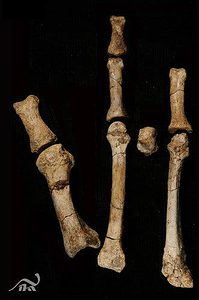Africa proves yet again that it’s the cradle of the hominid family, and in consequence the human species. Scientists have found foot fossils in Ethiopia that don’t match those of any kind of hominid discovered thus far, dating from 3.4 million years ago, making the specimen contemporary with Lucy, an Australopithecus afarensis specimen, of vast significance during its initial discovery as it presented evidence that it was adapted for upright walking. The new fossils, although very limited in number, proves one very interesting fact – the new discovered hominid didn’t use bipedal locomotion, but instead was more suited to climbing trees.

The discovery is of great importance, showing, among other highly fascinating facts, that the Australopithecus a. didn’t represent a single line of hominids during three to four million years ago, a period from which no other remains from a different species had been uncovered until now.
Australopithecus a. was well adapted to bipedal movement, as attested by Laetoli footprints in Tanzania from as early as 3.7 million years ago, and more evidently by its feet bone structure – a strong arch and the big toe lined up with the other four digits (are you looking at your feet yet? Lucy had similar feet to ours), a feature indispensable to bipedal locomotion. The new species, however, presents a divergent opposable toe, long digits as well as other bones that didn’t match the afarensis feet, closely resembling modern chimpanzees.
In fact, Yohannes Haile-Selassie, a paleoanthropologist at the Cleveland Museum of Natural History in Ohio, suggest that the newly found foot fossils bear a striking resemblance to the earlier hominin Ardipithecus ramidus, nicknamed Ardi, which lived 4.4 million years ago, in the same region known today as Ethiopia. The new fossils, comprised of only eight bones out of the usual 24, were unearthed in 2009 by Stephanie Melillo
[RELATED] Human ancestors started walking on two legs to carry more scarce resources, study suggests
The find proves that there was a more diverse locomotion among hominids than previously thought. Thus, one group decided to abandon their tree climbing way and settle for bipedality, while another maintained a climbing foot and stayed at least part time in the trees. As time passed, evolution showed that bipedal movement was more efficient, as all our post-Lucy ancestors retained their upward locomotion.
It’s clear that more fossils are needed to determine if this is indeed a new species, although it most likely is, and for at least sketching the individual which had these kind of feet attached to it. The site where the fossils were found was just recently excavated, so there might be a solid chance for finding even more remains.
“Human evolution is often portrayed as a triumph of bipedalism, but who among us has not occasionally regretted our species’ comparative clumsiness in trees?” wrote Daniel E. Lieberman, a human evolutionary biologist at Harvard who was not involved in the research. “I, for one, am pleased to know that some hominins retained feet well adapted for arboreality millions of years after we started to walk on two feet.
The findings were reported in the journal Nature.
[source]





